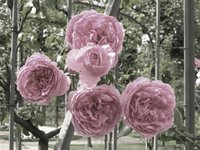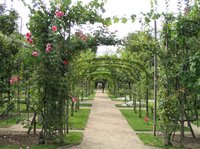Le Musée d'Albert Kahn

Ah, France. The land of formal landscapes and landscape designers like...well, okay, pretty much just André Le Nôtre, but Le Nôtre made a pretty big mark, and landscape design students still study him. In fact, most of the gardens of France - Versailles, Vaux-le-Vicomte, Villandry, and Chenonceau, to name a few - are on the tour of gardens for any self-respecting landscape designer who makes a trip to Europe. But few of them will discover the delight of the gardens established by a wealthy Alsatian banker in 1895.
Le Musée (et Jardins) d'Albert Kahn, located in Boulogne-Billancourt, on the western outskirts of Paris, is not to be missed by any student of landscape, or anyone looking for a rest from the noise of the city. I stumbled upon it purely by accident when I was living in Boulogne-Billancourt in 2003, and I'm very happy I did; it is one of my very favorite places in Paris. if not all of France. While not, strictly speaking, a botanical garden, the garden is composed of themed sections, from woodland meadow to formal garden, and is a must-see for any gardner or landscape design student, as well as for anyone who just wants a relaxing day in Paris.

In his vision of the future, Albert Kahn believed all the cultures of the world could not only get along, but thrive and flourish in proximity and synergy with one another, and he commissioned landscape architect Achille Duchene to design a garden to demonstrate this. The result is an amalgam of design and specimens from all over the world. Only 10 acres remain of the original 17, but what a treat they are. To wander through Kahn's gardens is to leave the world behind and lose oneself in the magic only nature contains. The passage from one area to the next is a surprise and treat, as no signs or bonundaries exist to demarcate one verdant area from the next. Upon leaving the museum building, one finds himself in a formal Japanese garden; go left, and the garden continues along the south wall of the property, stretching pretty much the entire length of the land. The first part is best, much more tightly structured and "correct," but I like the whimsy of the last, more recently-designed half of it, as well, despite the more modern, haphazardly seeming eccentricity of it. It makes a very pleasant stroll.
If you veer right instead, you find yourself in a pastoral "English garden" setting, travelling a curving path beneath tall trees and curving around to a footbridge crossing over the small creek. Between these two extremes lie a pine forest, palmitarium (where you can have a light lunch), an espaliered orchard and formal French garden, arid Alsatian pine forest, and a forest of blue pine. The number of plants is astounding, and the walk is a constantly surprising delight. It is my favorite garden in all the world, and truly wonderful, peaceful place to visit.

A humanitarian, Kahn also wished to establish a center where students from across the globe could gather to study the cultures of the world in the hopes of establishing an international civilization and world peace. He gathered a group of luminaries from the arts and sciences and called them the Autour du Monde. The group's goal was to promote international cooperation, and members included Colette, Albert Einstein, Anatole France, Andre Gide, Rudyard Kipling, and Rodin.
The philanthropist was also a forward-thinking man who realized the way of life for many people and societies across the globe was changing, disappearing forever. In an effort to preserve some record of lost culture, he dispensed photographers to travel to 50 countries from 1909 to 1931, and take photos and movies of the way everyday people led their lives. The resultant 72,000 photographs and 180,000 meters of silent film were gathered into the Archives de la Planéte, some of which is on display in the museum which is the entrance to the gardens. It is an interesting look at bygone days and a remarkable preservation of history. The collection includes rare photographs of the Basse-Normandy region taken in 1920, prior to German occupation and severely damaged during the D-Day invasion some 25 years later.
Albert Kahn lost his money in the stock market crash of 1929 and bankrupted himself using what money he still had on his gardens and photographic expeditions. Some years later, he was forced to sell the 17 acres of his garden, but believed he would be able to buy it back. Unfortunately, he died in 1940 with being able to do so. But the various institutions he established still survive to carry out his goal of conservation and preservation. And the beautiful gardens and photographic archives he established remain still, a crowning achievement in the life of this gentle humanitarian.
The price of admission to the museum and gardens is €3.30. You may take photographs, but you will have to sign an agreement stating they are solely for personal use. Albert Kahn is open October 1 - April 30, 11am - 6pm. May 1 - September 30, 11am - 7pm. Closed Mondays. It is located at 14, rue du Port in Boulogne-Billancourt (92100). Parking is non-existent, but it's painfully easy to get there by Metro. Take line 10 to the last stop, Boulogne Pont de Saint Cloud. Ascend and head north, northeast, across the traffic circle, to the rue du Port, which intersects with the larger rue des Abondences. Proceed left down rue du Port (the only way you can go), and it's about 2/3 of the way down the street, on the right. Entrance is to a low-lying building which looks a little like a community center. Light meals/snacks (quiche, salade nicoise) are served in the Palmitarium greenhouse for less than €10.
For more on the museum and garden of Albert Kahn, please see this article in the NY Times, which I consulted for part of this entry.
Images & text copyright 2006 - all rights reserved

0 Comments:
Post a Comment
<< Home